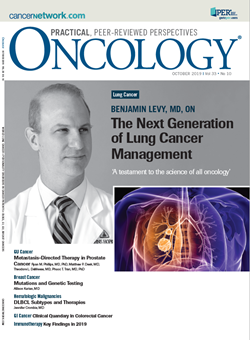Classifying DLBCL Subtypes for Optimal Treatment
Jennifer Crombie, MD, discusses classification of diffuse large B-cell lymphoma (DLBCL) into distinct subtypes and treatment decisions based on molecular classifications.
Jennifer Crombie, MD

ABSTRACT: DLBCL is the most common subtype of non-Hodgkin lymphoma, representing about 30% to 40% of cases. Patients are typically diagnosed with an excisional lymph node biopsy or a biopsy of another affected organ. When pathologists look under the microscope, they can see a diffused proliferation of large neoplastic B cells. These B cells are identified by flow cytometry or immunohistochemistry that identifies pan-B-cell antigens such as CD19, CD20, and CD79a, as well as CD45. DLBCL is known to be an aggressive lymphoma, but it is also known to be both clinically and molecularly heterogeneous.[1] Patients can have a range of clinical presentations, with disease of only one lymph node to more advanced-stage disease with extranodal sites of involvement. Just like patients can have a range of clinical presentations, outcomes can also be extremely variable, with approximately 60% of patients being cured with frontline chemotherapy. The remaining patients with refractory or relapsed disease have much poorer outcomes.
Molecular profiles allow for risk stratification
Recently, ONCOLOGY discussed the classification of diffuse large B-cell lymphoma (DLBCL) into distinct subtypes and treatment decisions based on molecular classifications. We spoke with Jennifer Crombie, MD, a medical oncologist at the Dana–Farber Cancer Institute in Boston, who specializes in the care of patients with lymphoma and takes part in clinical trials of lymphoma patients.
Q: Dr. Crombie, how is DLBCL generally diagnosed and what are the typical clinical and molecular characteristics of this tumor type?
Dr. Crombie: DLBCL is the most common subtype of non-Hodgkin lymphoma, representing about 30% to 40% of cases. Patients are typically diagnosed with an excisional lymph node biopsy or a biopsy of another affected organ. When pathologists look under the microscope, they can see a diffused proliferation of large neoplastic B cells. These B cells are identified by flow cytometry or immunohistochemistry that identifies pan-B-cell antigens such as CD19, CD20, and CD79a, as well as CD45. DLBCL is known to be an aggressive lymphoma, but it is also known to be both clinically and molecularly heterogeneous.[1] Patients can have a range of clinical presentations, with disease of only one lymph node to more advanced-stage disease with extranodal sites of involvement. Just like patients can have a range of clinical presentations, outcomes can also be extremely variable, with approximately 60% of patients being cured with frontline chemotherapy. The remaining patients with refractory or relapsed disease have much poorer outcomes.
Clinically, when we think about how to identify these patients to risk stratify them, we can use the International Prognostic Index. This has been the mainstay of risk stratification and incorporates a variety of clinical characteristics such as age, lactate dehydrogenase, performance status of the patient, and number of extranodal sites, as well as Ann Arbor staging. Using these criteria, we are able to stratify outcomes to frontline therapy. As far as the molecular characteristics, although there are a variety of genomic alterations, there is not a specific defining molecular feature, again highlighting the heterogeneity of this type of lymphoma.
Q: In the last several years, there have been studies that have identified a few different subtypes of DLBCL. Could you talk about the rationale for doing these studies and how these were done?
Dr. Crombie: As I mentioned, there is a wide range of clinical heterogeneity. There have been efforts to understand what biologic underpinnings could drive these differences in outcomes. The initial studies done almost 20 years ago used gene expression profiling, which is a laboratory test that looks at the expression of thousands of genes. This identified two molecularly distinct subtypes of DLBCL, and the genetic profiles were believed to reflect different stages of B-cell development. This is why this is known as “cell of origin.” The first subtype is germinal center >B-cell–like (GCB)-DLBCL.
These lymphomas express genes that define the GCB before it has left the germinal center. The other main subtype of DLBCL is the activated B-cell–like (ABC)-DLBCL. In this subtype, the transcriptional signature resembles B cells in the post-germinal center, which are blocked at the phase where they would have plasmablastic differentiation. More recently, there have been newer gene expression profiling tools such as the NanoString assay that can decrease the number of genes involved from thousands down to 20 genes and uses fixed tissue. The common assay known as lymph2Cx has been tested in clinical trials and has good concordance with standard gene expression profiling.
As I mentioned, the main reason to do these studies is to try to identify patients with higher-risk disease who may benefit from more intensive chemotherapy. It has been shown that patients with ABC subtype have an inferior outcome following traditional chemoimmunotherapy, which is rituximab, cyclophosphamide, doxorubicin, vincristine, and prednisone (R-CHOP). There are two other subtypes of DLBCL worth noting that have independent prognostic information beyond the cell of origin. These are lymphoma abnormalities of the MYC oncogene. Specifically, the GCB subtype of lymphomas can commonly have translocations that involve MYC with BCL-2 and/or BCL-6. These have unique names, double-hit or triple-hit lymphomas, and are now recognized by the World Health Organization as a unique entity known as high-grade B-cell lymphoma with translocations involving MYC and BCL-2 and BCL-6. This just highlights the prognostic significance of these genomic abnormalities. Similarly, lymphomas that have high protein expression of MYC, BCL-2, or BCL-6 are double-protein-expression lymphomas. These have also been shown to have a poor prognosis with frontline therapy. [3]
The reason for doing these studies has been to identify patients who may benefit from therapies other than R-CHOP. This has been looked at in a variety of clinical trials, but not yet with success. There has been a randomized phase II trial that combined bortezomib with R-CHOP and a phase III randomized trial, the PHOENIX trial, which added ibrutinib to R-CHOP, and compared to R-CHOP alone, failed to show an improvement in patients, specifically in non-GCB or ABC subtype lymphomas. Thus far, while this information on DLBCL subtype information provides prognostic value, it has yet to really change the way we approach treatment for these patients. More recently, there have been advances. Using next-generation sequencing and whole-exome sequencing, there have been more genomic abnormalities that have been appreciated and have exposed heterogeneity even within the cell of origin.
Q: Are there any other studies that have tried to further classify DLBCL?
Dr. Crombie: There have actually been a few studies published in the last year or two that have further dissected the underlying genomic profiles of DLBCL and identified subgroups beyond cell of origin. Specifically, the authors of these studies have looked at a range of genomic abnormalities, including point mutations, copy number alterations, and structural variants, which all seem to be important in this disease in terms of the classification. As I mentioned, interestingly, these additional studies have revealed heterogeneity among the traditional cell-of-origin classification. These results maybe explain why some of the prior studies, which added targeted therapy to traditional R-CHOP for patients with ABC subtype, for example, have not been successful to date.
Recent work from Dr. Margaret Shipp’s lab at the Dana–Farber Cancer Institute has identified five distinct subtypes of DLBCL.[4] In their study, they looked at a large cohort of patients with DLBCL who were previously untreated, looked at a range of genomic abnormalities, and used nonnegative matrix factorization consensus clustering to identify distinct clusters of patients based on their genomic signatures. What they found was that the significant signatures correlated with outcomes data and both high-risk and low-risk GCB subtype lymphoma, as well as high-risk and low-risk ABC subtype lymphoma, and a group that was cell-of-origin independent. Other groups besides the group at Dana–Farber have similarly used whole-exome sequencing and genomic next-generation sequencing platforms to identify a range of abnormalities and use this information to further cluster or further categorize patients with DLBCL. I think this information will also be really helpful in the clinical trials to try to more rationally add targeted therapies to the backbone chemoimmunotherapy for specific subgroups and again
Q: Overall, are these assays generally in the clinic in patients not involved in clinical trials or the academic setting?
Dr. Crombie: The NanoString assays have been used in clinical trials successfully. These are not routinely used in clinical practice. We do have ways to use immunohistochemistry staining as a surrogate to gene expression profiling to assign cell of origin. This is known as the Hans algorithm, looking at specifically CD10, BLC-6, and MUM1. But there are limitations to this type of surrogate marker, as it is not as accurate. As I mentioned, using this information has yet to really change the treatment approach. So, I think that all of this information is going to have to be applied to the clinical trial setting where we can use it to design trials of rationally targeted therapies and work toward improving personalized treatment strategies.
Q: Finally, what do you see as the evolution of DLBCL subtypes? Are there unanswered questions about the biology of DLBCL that could help clinicians make better therapy decisions for their patients?
Dr. Crombie: There are so many unanswered questions in the field. I think many of the recent studies have highlighted that the genomics are much more complex than we previously thought and that there is significant heterogeneity. But these studies have moved us closer to a better understanding of which patients are highest risk, which patients we should really focus our energy on and develop clinical trials for, which patients don’t need additional therapy, and for which R-CHOP would be an adequate treatment approach. I think that it’s an exciting time in the field and there is a lot to be learned with subsequent trials.
Key Question
Recently, researchers at the British Columbia Cancer Centre for Lymphoid Cancer in Vancouver and the Princess Margaret Cancer Centre–University Health Network in Toronto identified a novel subtype of DLBCL. Can you talk about whether they used similar approaches as other studies you described and place these results in the context of whether these subtypes are relatively fluid and more of a moving target?
Dr. Crombie: The authors of the study [2] used a similar approach to the initial gene expression profiling that identified cell of origin, but they used RNA sequencing rather than DNA microarrays. Specifically, they looked at 157 patients with germinal center B-cell lymphoma, including a subgroup that had double-hit and triple-hit lymphomas, and then identified a gene expression signature for the double-hit and triple-hit lymphomas. When they then applied this signature, which was based on 104 genes, they found that even patients who didn’t traditionally meet the criteria of double-hit or triple-hit lymphoma based on fluorescence in situ hybridization or identification of cytogenetic abnormalities shared the same transcriptional profile.
Similarly, they had an inferior outcome to frontline therapy. So, using this tool, the researchers were able to identify a group of patients who would otherwise have been missed as having a high-risk disease. Specifically, they found that patients with this double-hit signature had a high incidence of mutations within chromatin-modifier genes and few infiltrating T cells. This group of patients also had abnormalities in genes involved in oxidative phosphorylation. The authors wondered if adding therapies that could target these abnormalities could be beneficial in these high-risk patients. Then, to make it more clinically relevant, they went on to create a 30-gene NanoString-based assay that could classify these patients in a more clinically utilized fashion. The hope would be that we could use this information in clinical trials to identify more intensive regimens or alternative therapies that could improve outcomes.
Financial Disclosure:The author has no significant financial interest in or other relationship with the manufacturer of any product or provider of any service mentioned in this article.
PERSPECTIVE

Molecular Subtypes of DLBCL and Choice of Therapy – 20 years in Making
Grzegorz S. Nowakowski, MD
It has been nearly 20 years since the molecular subtypes of DLBCL based on the cell of origin (COO) have been first described as associated with a distinct biology and prognosis.[1,2] Much work has been done since to make determination of COO readily clinically available through immunohistochemistry or novel, rapid gene expression platforms using paraffin tissue.[3-5] This work has been largely done to facilitate the development of new therapies targeting the activated B-cell like (ABC) subtype of DLBCL, which is associated with a worse outcome and distinct signaling pathways allowing for incorporation of ABC subtype specific targeted therapy.[6-9] ABC DLBCL is also referred to as a non-germinal center subtype (non-GCB) in immunohistochemical classification.
Despite this work, the results of front-line trials targeting the ABC or non-GCB DLBCL subtype by adding new agents to standard RCHOP chemotherapy (so called X-RCHOP combinations, where X stands for added targeted agent) have been disappointing. While there are multiple reasons why these approaches might not have worked, the common problem is that ABC patients in clinical trials do much better than expected based on retrospective database studies. As it turns out, patients with DLBCL with rapidly progressive disease start therapy urgently, frequently in the hospital.[10] These patients have high risk disease but unfortunately are not enrolled in clinical trials due to the complexity of screening testing, including the need for centrally assessed molecular classifier. Patients with a good prognosis are more likely to enter the trial – making measuring of the effect of new agents very difficult, if not impossible. In other words – our clinical trials simply did not capture real world patients.
What does the future hold for COO for the selection of therapy? We now recognize that COO subtypes are molecularly and biologically heterogenous, as identified by mutational clustering. Indeed, a subset of ABC patients have relatively good outcomes, while subset of GCB patients fare worse than expected for the GCB subtype.[11,12] This new understanding of molecular clusters of DLBCL will likely fuel future trial development. Whatever we do however, we need to make sure that these trials allow for the inclusion of rapidly progressing, sicker patients without any delay. These patients have the most to gain from novel therapies.
FINANCIAL DISCLOSURES: Dr. Nowakowski has consulted for, or been funded by, Bayer, Celgene, Selvita, NanoString, Morphosys, and Seattle Genetics.
Dr. Nowakowski is Hematologist, Oncologist, Researcher, and Associate Professor at Mayo Clinic in Rochester, Minnesota.
